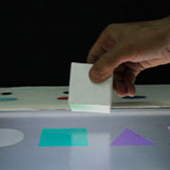The traditional screen based interfaces and disciplines like virtual reality, which embedded people into virtual world and were seen as estranging people from the real world. Additionally, with technology becoming cheaper, smaller, smarter and coming quickly to the market, it was possible to embed information into our surrounding objects, spaces, environment, fabrics etc. This motivated the development of the discipline called Tangible User Interface.
The notion of Tangible User Interface constituted an alternative vision for computer interfaces that brings computing back into the real world, which was originally conceived in the mid 90’s. (Wellner, Mackay, Gold 1993; Ishii, Ullmer 1997).Tangible user interface was envisioned as an alternative to graphical user interface. It was proposed to represent digital content through tangible objects, which could then be manipulated via physical interaction with tangibles. The idea was to grasp data with hand and to unify representation and control. The thought behind it was to use physical devices to interact with digital content.
In 1996, Fitzmaurice's PhD thesis had explored the use of graspable bricks as a more direct input mechanism for the interaction with graphical representations. It also suggested the use of multiple graspable objects instead of the generic input device such as mouse, keyboard etc. An early example of TUI was marble answering machine by Durrel Bishop in early 1990s, where marbles were used to represent message left on answering machine. Placing those marbles plays the message recorded in it.
Similarly, MIT’s Tangible Media Group developed a project called Urp (Urban Planning Workbench), where they created a map that was manipulated with placing iconic representation of central buildings on it and moving these apart. The Urp and the more advanced Augmented Urban Planning Workbench allowed digital simulations of air flow, shadows, reflections, and other data based on the positions and orientations of physical models of buildings, on the table surface.
Later, researchers and scientists around the world developed interesting projects such as Topbo, Jive, Reactable, Microsoft Surface, Siftablesand many more. Today almost every appliance contains electronic & digital components and becoming smart & intelligent, which has formed new challenges and opportunities to bring back various design disciplines together. TUI not only includes the interface, but aspects such as form factor, physical properties of the object, materials, technology etc. forced computer scientists, interaction designers and industrial designers to focus on designing complex behaviour that is digitally controlled.

